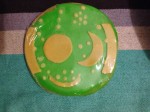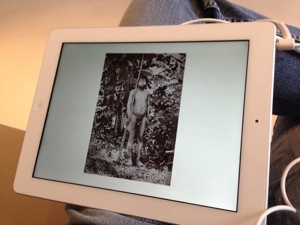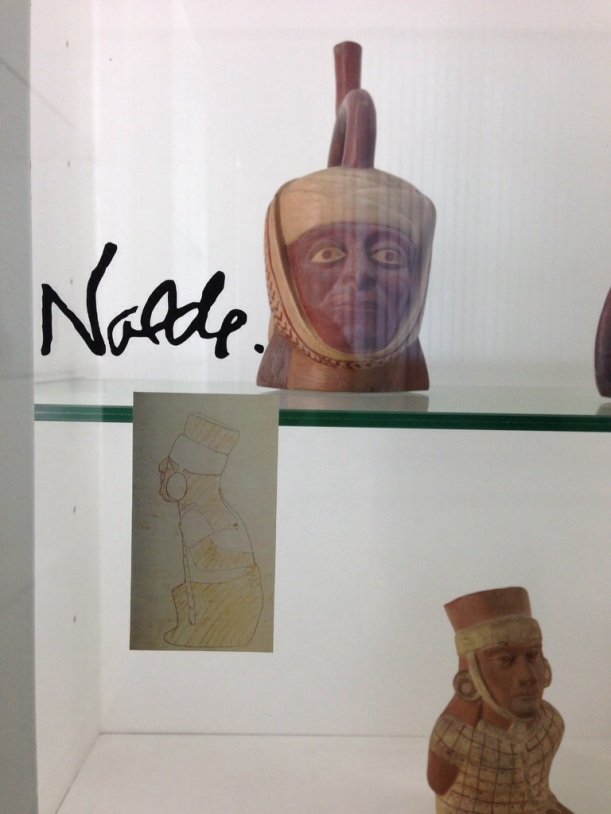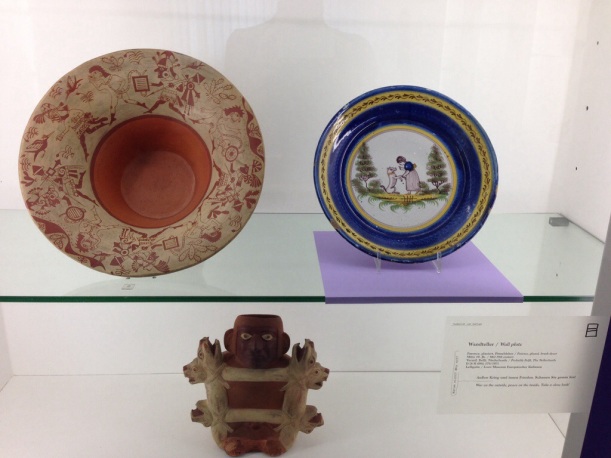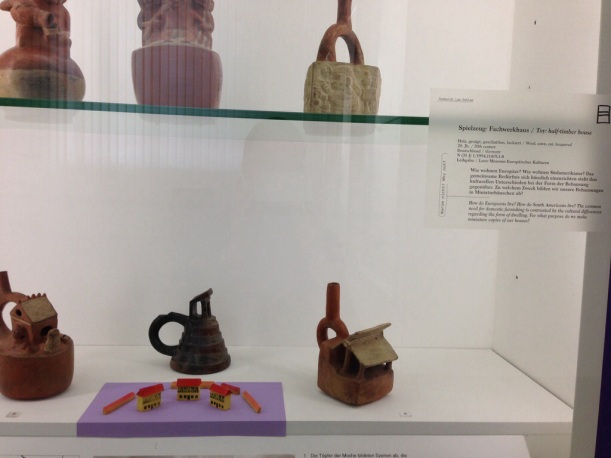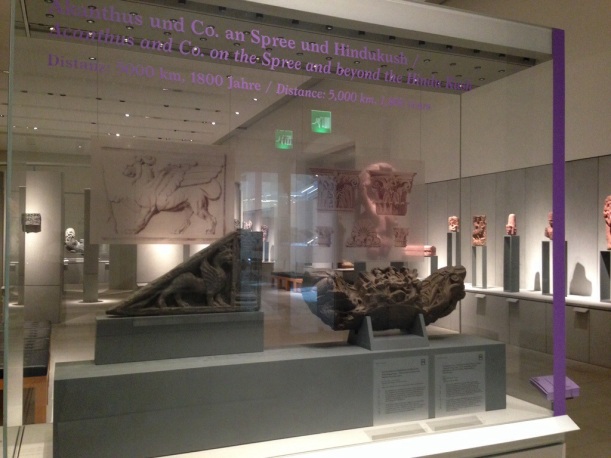Eigentlich wollte ich ja über das Museum etwas später schreiben, sozusagen meine Athener Erfahrungen erstmal sacken lassen. Da aber vor einigen Tagen neue Bewegung in den Fall der Elgin-Marbles gekommen ist, ist es vielleicht ganz schön, dieses Museum vorzuziehen und hier gleich einzubinden. Immerhin wurde es ja hauptsächlich deshalb gebaut, um den Parthenon-Friesen, die heute im British Museum ausgestellt sind und um 1820 nach Großbritannien kamen, eine neue/alte Heimat zu bieten.
Das Neue Akropolis-Museum hat auf jeden Fall zwei Seiten. Eine ist die politische. Die andere die museologische. Und beide gehen Hand in Hand, was eine Beschreibung nicht einfacher macht!
Als politische Forderung der Rückgabe der Parthenon-Friese (auch bekannt als Elgin Marbles im eher englischsprachigen Raum) beruht auf der Annahme, die Friese wären von Lord Elgin unrechtmäßig nach Großbritannien ausgeführt worden (zusammengefasst etwa hier letzthin beschrieben). Andererseits beharrt das British Museum darauf, dass die Ausfuhr und auch der spätere Ankauf durch das Museum rechtmäßig waren, da es hierfür Dokumente geben soll (hier in kurzer Form dargestellt). Ich möchte hier gar nicht einsteigen, denn weder bin ich in der Diskussion wirklich kundig, noch gibt es hierfür den Platz. Eine schöne, längere Einführung zu diesem sehr kontroversen Thema findet sich im Buch “Loot” von Sharon Waxman, das ich hier schon einmal vorgestellt habe, neuere Entwicklungen kann man im Internet unter dem Stichwort “Parthenonfries Rückgabe” (oder ähnlich) sehen.
Auf jeden Fall geht es hier nur vordergründig um die Frage ob Friese (un)rechtmäßig ausgeführt wurden – eigentlich geht es um Fragen von Kolonialismus. Ähnliches geschieht seit Jahren mit dem Fall Nofretete in Berlin, in dem auch immer wieder Debatten angestoßen werden, die eigentlich auf Dokumenten und rechtlichen Fragen beruhen, die eigentlichen (post)kolonialen Fragen aber außen vor lassen.
Aber eigentlich ging es ja nun um das Museum an sich. Sichtbar ist das Museum bereits, wenn man am Parthenon steht und auf die XXXX Seite Athens hinunterblickt. Gleich hinter dem Dionysos-Theater findet sich das Museum, ein heller, gläserner Bau. Kommt man dem Gebäude näher, sieht man vor allem eines: der Eingang ist vertieft, darüber erhebt sich ein verglastes Gebäude, dessen oberster Stock fast völlig einsehbar ist. Selbst von draußen sind die Stücke des Parthenons-Frieses, Repliken, etc. schemenhaft erkennbar. Unter den Füßen sieht man die Ausgrabungsstätten der Umgebung der Akropolis zwischen 500 vC – 700 nC, die, so wie sie sind, ins Museum integriert wurden und später begehbar sein sollen. Bislang liegen sie einem zu Füßen.
Da übrigens das Museum Fotos nur an sehr ausgewählten Orten erlaubt, sei hier auf die Website verwiesen, die viele Fotos anbietet. Meine Fotos stammen von den Außenbereichen. Und noch ein kurzes Wort zu Familien & Kindern. Zwar war ich in diesem Museum alleine, es gibt aber mehrere Kinderecken, spezielle Kinderführungen und Kinderinformationen. Familien erhalten wohl einen speziellen Familien-Pack am Eingang, mit Gadgets für Familien mit Kindern. Mein Favorit war die nachgebaute Akropolis aus Legosteinen!
Auf jeden Fall: Dieses Museum ist mehr als ein Museum. Es ist ein Ort der Einkehr in die klassische Welt, so wie Griechenland und die Besucher sie sich wünschen. Räumlich so großzügig geschnitten dass selbst die vielen Besucher sich verlaufen und man sich alleine, ungestört fühlt, in ruhiger Betrachtung der Statuen, Keramiken, Friese. Ein unglaublich schönes Gefühl, gerade wenn der Blick aus den Glasfronten immer wieder gegenüber auf die Akropolis fällt, deren Parthenon die gleiche Ausrichtung und Größe hat wie das oberste Stockwerk des Museums. Der Genius Loci ist hier zuhause.
Mein Studium der Klassischen Archäologie dauerte nur 2 Semester und endete aufgrund der Sinnlosigkeit von Diskussionen über die Handhaltung zerbrochener Statuen. Zusammengefasst kann ich sagen, dass mir die Irrelevanz dieses Studienfaches für mich selbst damals klar wurde. Trotzdem übt die Antike, das Aufkommen der Demokratie und die griechischen Stadtstaaten immer noch eine Faszination aus, die vielleicht auch kulturell bedingt ist. Akropolis und Neues Akropolis-Museum waren also ein Magnet in Athen und ich habe die verständlichen, nicht zu langen, aber auch nicht zu kurzen Texte genossen, die mir Überblick über die einzelnen Phasen der Entwicklung der Akropolis und des alten Griechenlands im Allgemeinen boten. Ich mochte die Statuen, die Keramiken, die wunderbare Beleuchtung. Sei es im Tageslicht, durch die riesigen Glaswände, oder im Aufgang bei eher weichem Licht für die Keramiken. Helle, weiße Oberflächen wiederholen die Idee der weißen Antike, so überholt diese auch sein mag. Und dieses Weiß schafft eine helle, ruhige Atmosphäre.
Innerhalb des Museums gibt es insgesamt 3 Stockwerke, die die verschiedenen Areale der Akropolis wie auch die unterschiedlichen zeitlichen Phasen abbilden, sei es in Keramik oder den Statuen. während es im Treppenaufgang um die Akropolis und ihre einzelnen Areale geht, ist der erste Stock vor allem der archaischen Akropolis mit ihren Dutzenden von Korai (Votivstatuen junger Frauen) gewidmet. Der Zwischenstock birgt einen der beiden Museumsshop, das Café, die Karyatiden und Informationen zum Parthenon.
Der oberste, dritte, Stock ist ganz den Parthenonfriesen gewidmet, denn das Parthenon ist hier architektonisch nachgebildet, sodass man sowohl die inneren wie auch die äußeren Friese in der Größe und Aufrichtigen sieht wie es auf dem Parthenon der Fall wäre, das sich hinter dem Fenster auf der Akropolis erhebt. Idee war hier, die – zurückbekommenen ?! – Teile der Friese wieder einzufügen sodass das Parthenon im Museum praktisch aufersteht. Da dies aber nicht der Fall ist, hat man sich bislang mit den Originalen beholfen, die in Athen verblieben sind sowie mit einigen Repliken. Viele Paneele bleiben auch einfach leer. Ihnen gegenüber immer wieder die Möglichkeit zu sitzen, zu schauen. Einzelne Statuen und Infotafeln geben weitere Informationen zum Parthenon, dem Stil, einzelnen Details, der Nachvollziehung dargestellter Szenen, die ja teilweise nur noch schemenweise sichtbar sind.
Wer um diese Galerie im 3. Stock herumwandert, bekommt jedoch hauptsächlich eine gefühlte Idee davon, wie es gewesen sein mag, im alten Athen das Parthenon zu betreten und sich dort aufzuhalten. Es ist ein großartiges Gefühl, und das sage ich jetzt als klassisch recht unbeschlagener Mensch, der sich einfach der Schönheit und dem Genius Loci hingibt. Ich kann keine Analysen zu den Statuen liefern, ich kenne auch nicht alle mythischen Geschichten dahinter. Und ich habe keinen Audioguide. Ich laufe einfach nur ganz in Ruhe um die Galerie herum. Innen und außen in der Galerie, betrachte die vorhandenen oder nicht vorhandenen Paneele und sinniere über die Geschichte. Es ist ein sehr besonderes Museum mit einem besonderen Gefühl.
Obwohl ich im Museum keine explizite Information zum Thema der Rückgabefrage gefunden habe, machen die Paneele in der obersten Galerie sehr deutlich, was hier fehlt. Auch der zweite Besuch gab keine Informationen darüber her, ob und wie hier mit dem Thema der Rückgabe des Frieses umgegangen wird. Auch die offiziellen Bücher im Museumsshop konzentrieren sich auf die Objekte, und nehmen keinen Bezug auf Politisches. Wer nichts über die politische Seite der Akropolis weiß, wird hier nicht informiert, es geht schlicht und ergreifend um das Klassische Athen. Und das wird hier auf wunderbar gestaltete Weise wieder lebendig.
ENGLISH VERSION
Actually, I wanted to write about this museum a little bit later on, lets say when my Athenian experiences settled down a bit. But as there have been movements in the case of the Elgin Marbles in the last few days, I decided to do it right away. Because the New Acropolis Museum was built to house the whole of the Parthenon Frieze (the parts being currently in Britain also known as Elgin Marbles) and to offer a new home of all of the frieze in Greece. So, the New Acropolis Museum definitely has two sides to it: a political. And a museological. Both go hand in hand, which doesn´t help when describing this beautiful museum.
The political claim of restituting the Elgin Marbles is based on the assumption that these were taken away by Lord Elgin on an illegal basis to Great Britain in the 19th century (see a short version of the events here). On the other hand, the British Museum refuses this claim on the basis of the legality of the export and later buying of the marbles by the museum because of certain legal documents presented at that time (have a look at this part of the discussion here). I don’t want to take sides in that, I have no deep knowledge of the case, nor is this the place to do it. If you´d want to have a longer, more detailed introduction to it, have a read at the part of “Loot” of Sharon Waxman that deals with the Elgin Marble – topic. Newer developments are avaibale at the internet.
Anyway, the question of the friezes coming back to Greece and if they were exported illegally in the first place is a rather superficial question. Actually, the question(s) and the debate(s) are on colonialism. Similar things are happening around the topic of Nofretete in Berlin, where claims of restitutions are being issued on a rather regular basis. Based on legal documents, these also draw on post(colonial) questions, that are being left out in the legal debate.
But, this blog post was to be on the museum itself, which is visible even from the Acropolis. If you’re standing at the Parthenon you can devise it on the other side, directly behind the theatre of Dionysos. Its a building in light color, with a lot of glass, and when you come nearer you’ll see that it is partially subterranean. But even from the outside you can make out parts of the Parthenon frieze inside, you may see parts of statues, or replicas. Below your feet is a glass floor through which you can see the excavations of the surroundings of the Acropolis from 500 BC up to 700 AD and at some point, when the excavations are complete and the whole subterranean area has been conservated, you ´ll may visit these excavations – by now they’re only visible form above.
Something on the side: the museum unfortunately allows to make photos only in very restricted and selected areas, so all my photos are from the outside buildings. You may have a look at the website, which offers nice photos of the museum. And a short aside to the topic of families and children: I went alone this time, but I was informed that families get a special family-pack at the entrance with educational gadgets and the like. Different children’s areas exist, together with quiet reading areas. There are special informations for children, children tours – and I liked the lego model of the Acropolis best!
In any case: this museum is more than a “Museum”. Its a location of contemplation of the classical world, such as Greece and the visitors would like it to be. Spatially, the museum is so large that even huge amounts of visitors find sufficient space and you may feel alone, undisturbed in your quiet gazing at statues, ceramics, friezes. I went to the museum twice, on Friday evening and sunday afternoon, and even with masses of people going there on sunday it had a quiet quality to it, mainly based on the high ceilings and the overall spatial disposition of its rooms and galleries. Its a wonderful feeling to be there, especial when your view is diverted every now and then to the acropolis right across the street, looming up high in an greek sky of pure blue. Through large glass panes the Parthenon itself is visible, showing the same size and orientation as the top floor of the museum. Genius Loci is at home here.
My studies of Classical Archaeology only went on for a year and that has been some time ago. They ended because of what I felt was the senselessness of ongoing debates in class about the original disposition of a hand of broken statues and the like. I must admit that the relevance of these details never got to me – I am more fond of actual interpretation of data, be they from excavations, surveys or analysis. But nevertheless, Antiquity, the rising of European democracy and the greek city states radiate a fascination which may be culturally induced but work nevertheless. In me and many other people! The Acropolis and the New Acropolis Museum thus were one of my main sights to be seen in Athens and I rather indulged in the not too short – not too long information texts the Museum offers on the development of the Acropolis, especially in Archaic and Classical times. I admit, I just liked the statues, the ceramics, the wonderful lighting. If its in daylight, through massive glass panes, or in the entrance ramp in a soothing light with the ceramics. White, translucent surfaces keep up our idea of the White Antiquity, as outdated as that may be. And white creates a clear, quiet atmosphere.
After getting an introduction to the surroundings of the Acropolis via the excavations below your feet, you’ll be informed on the Acropolis and the Sanctuary of the Nymph, with a side dish of Athenian Marriage in classical times. Another sector of the entrance ramp offers information on Greek everyday life. And while the first floor is entirely dedicated to the archaic Korai (early votive statues) and early Acropolis, the second floor holds a cafe, a museum shop, a reading area and the Karyatides. The top floor is dedicated to the Parthenon, as we know it by now – the classical one.
So, the top floor, dedicated to the Parthenon friezes, has been remodeled to match the Parthenon. You can see whatever´s left of the friezes in the same size and orientation as the Parthenon itself up in the Acropolis would have been. The inner and outer friezes (their replica or even blank spaces) are presented in a way that corresponds to the original, antique disposition. The whole idea of this floor was to include the friezes now in London and other parts of the world so that the visitor may get an idea of the original Parthenon – as this is not the case and may parts of the frieze remain abroad, replicas have been filled in in some areas, others stay just blank. Single statues on the side and additional information is offered to give more information on the Parthenon itself, the styles, several details of the frieze and so on.
Whoever wanders in this gallery, gets a feeling of how it my have been to enter the Parthenon in classical times and to stay there. Its a wonderful feeling – and I say this mainly as a person with no scientifically induced feelings towards Antiquity. But even so, you can feel the beauty, the genius loci. I couldn’t analyze the statues in any archaeological or art historical way, I don’t know all the mythical histories behind their stories. I don’t use an audioguide. I just walked along, sat down, gazed, wandered again. Again and again I contemplated the panels and thought about history. I may gaze up to the Acropolis and then around me again. This is a very special museum with a very very special feeling to it.
Although I couldn’t find any information on display concerning the restitution debate, the panels in the Parthenon gallery just make it clear what is lacking here. Even a second visit didn’t reveal any written information on this sensible topic. And the books at the museum shop offer “only” architectural and art historical information. If you don’t know anything on the political side of this museum and its objects you won’t get to know it here. It´s about Classical Athens. And this comes alive in this museum in a wonderful way.








